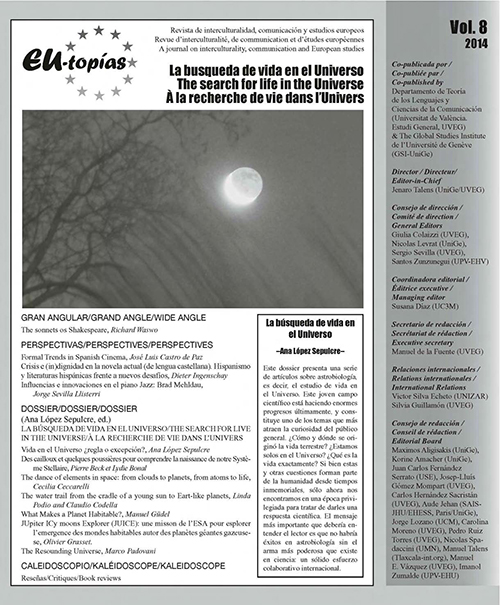The dance of elements in space: from clouds to planets, from atoms to life
DOI:
https://doi.org/10.7203/eutopias.0.18776Parole chiave:
Formación estelar, moléculas, vida Abstract
Abstract
Este artículo describe el camino recorrido por los átomos creados en el interior de las estrellas, que uniéndose entre sí forman moléculas cada vez más complejas a medida que una estrella como el sol y su sistema planetario se forman. Empezando por una mera nube de gas difuso compuesto por átomos flotantes, han hecho falta 4500 millones de años para construir el Sistema Solar, culminando con la más compleja estructura molecular conocida en el Universo: la vida.
 Downloads
Downloads
 Riferimenti bibliografici
Riferimenti bibliografici
CASELLI, Paola and CECCARELLI, Cecilia (2012), “Our astrochemical heritage”, The Astronomy and Astrophysics Review, 20, 56 (http://fr.arxiv.org/abs/1210.6368)
CECCARELLI, Cecilia, CASELLI, Paola, BOCKELEEMORVAN, Dominique, MOUSIS, Olivier, PIZZARELLO, Sandra, ROBERT, François, and SEMENOV, Dmitry (2014), “Deuterium Fractionation: the Ariadne’s Thread from the Pre-collapse Phase to Meteorites and Comets today”, In Protostars and Planets VI, University of Arizona Space Science Series (http:// fr.arxiv.org/pdf/1403.7143v1)
DAWKINS, Richard (1990), The selfish gene, Oxford University Press.
DE DUVE, Christian (2005), Singularities: Landmarks on the pathways of life, Cambridge University Press.
MORBIDELLI, Alessandro, LUNINE, J.I., O’BRIEN, D.P., RAYMOND, S.N. and WALSH, K.J. (2012), “Building terrestrial planets”, Annual Reviews Earth and Planetary Science, 40, 251
SALADINO, Raffaele, BOTTA, Giorgia, PINO, Samanta, COSTANZO, Giovanna, and DI MAURO, Ernesto (2012), “Genetics first or metabolism first? The formamide clue”, Chemical Society Reviews, 16, 5635
For an update list of the molecules discovered in the interstellar space look at http://www.astrochymist.org/astrochymist_ ism.html or http://www.astro.uni-koeln.de/cdms/ molecules
Downloads
Pubblicato
Come citare
-
Abstract198
-
PDF 65
Fascicolo
Sezione
Licenza
![]()
Tutti i contenuti pubblicati in EU-topías. Rivista di interculturalità, communicazione e studi europei è concesso in licenza Creative Commons Attribution-NonCommercial-ShareAlike 4.0. Il testo completo della licenza è disponibile all’indirizzo http://creativecommons.org/licenses/by-nc-sa/4.0
Essi possono essere copiati, utilizzati, diffusi, trasmessi e visualizzati pubblicamente, a condizione che ciò avvenga:
- Viene citata la paternità e la fonte originale della pubblicazione (rivista, editore e URL dell’opera).
- Non vengono utilizzati per scopi commerciali.
- L’esistenza e le specifiche di questa licenza d’uso sono menzionate.



